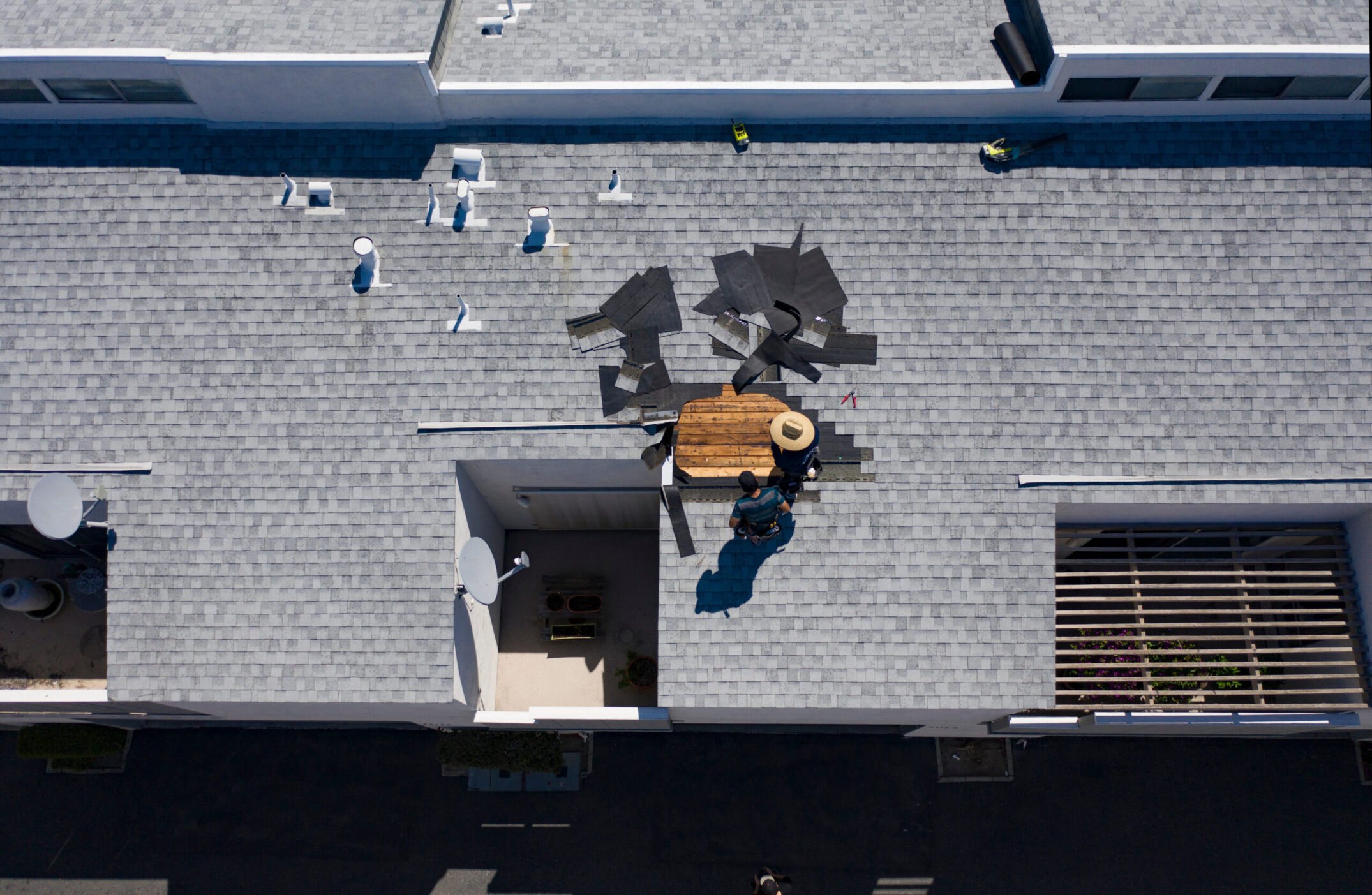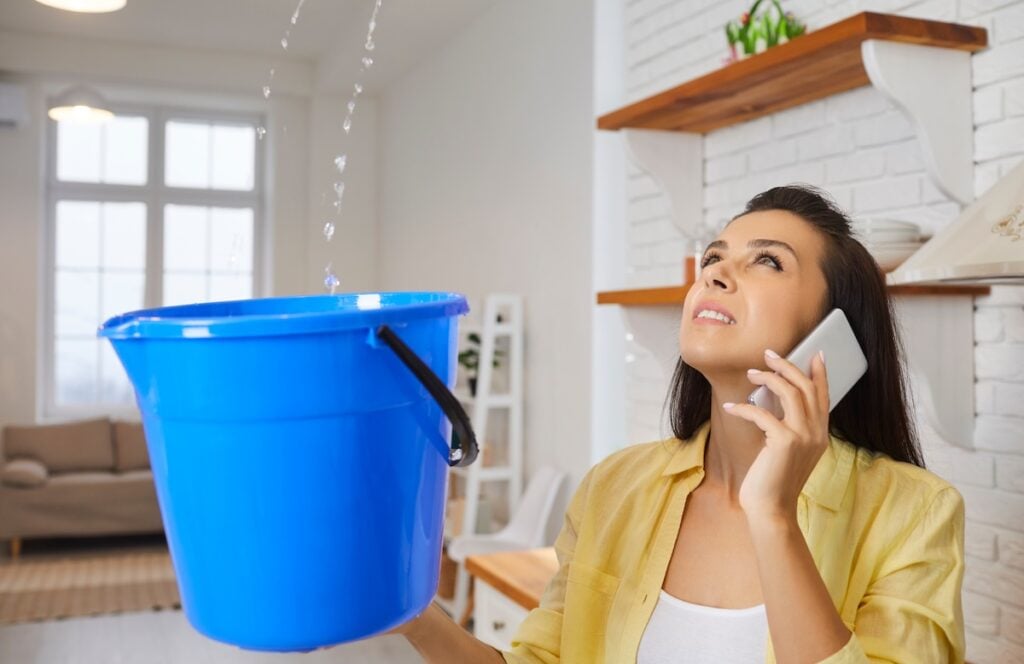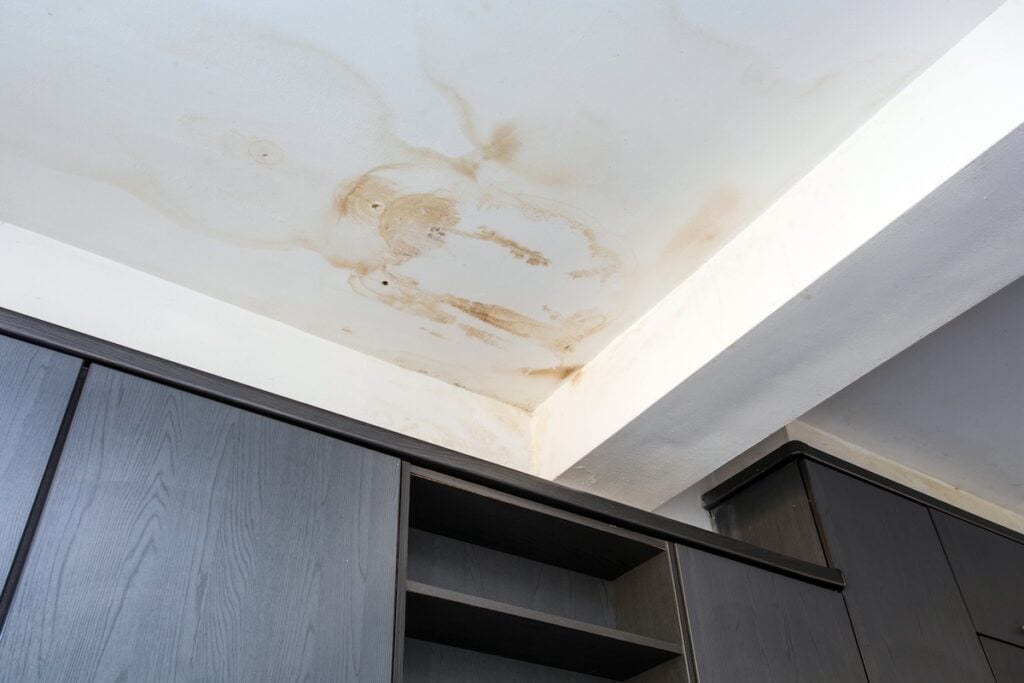8 Actions To Take If You Have A Leaky Roof
Posted 8.04.2025 | 7 Minute Read

Finding water dripping from your ceiling or spotting water stains can be alarming. A leaky roof demands immediate attention to prevent extensive damage to your home’s structure, belongings, and your family’s safety. Whether you’re dealing with a small drip or a more significant leak, knowing how to respond quickly can save you thousands of dollars in repairs.
This comprehensive guide covers everything you need to know about handling a leaky roof emergency. We’ll walk you through immediate safety steps, temporary fixes, when to call professionals, and how to prevent future leaks. You’ll also learn about the common causes of roof leaks and what to expect during the repair process.
Here’s what we’ll cover:
- Immediate safety measures to protect your family and property
- Step-by-step emergency actions for a leaky roof
- How to identify the source of your roof leak
- When to call a roofing contractor versus handling it yourself
🦺 Immediate Safety Measures

Your safety comes first when dealing with a leaky roof. Water and electricity don’t mix, so start by turning off power to any areas where water is entering your home. Check for wet electrical outlets, light fixtures, or appliances near the leak. If water has reached electrical components, contact an electrician immediately.
Move furniture, electronics, and valuable items away from the affected area. Place buckets, pots, or containers under active leaks to catch water and protect your flooring. If water is pooling in your ceiling and creating a bulge, carefully puncture the lowest point with a screwdriver to allow controlled drainage into a container below.
- Be cautious when walking on wet floors, as they can become extremely slippery.
- Place towels around leak areas to absorb excess water and prevent slip hazards.
- If the leak is severe or affecting multiple areas, consider evacuating the affected rooms until professional help arrives.
🚫 8 Emergency Actions for a Leaky Roof

A leaky roof can cause serious damage to your home, including water damage, mold growth, and structural issues. Taking quick emergency action helps minimize these risks and prevent costly repairs.
1. Document the Damage Immediately
Take photos and videos of the leak, water damage, and affected areas before making any temporary repairs. This documentation will be crucial for insurance claims. Capture images of the exterior roof area if safely accessible, interior damage, damaged belongings, and the leak’s progression over time.
2. Locate the Source of the Leak
Finding where water enters your roof can be challenging since water often travels along beams and other surfaces before dripping into your living space. Start by examining your attic or crawl space with a flashlight. Look for wet insulation, water stains on wood, or active dripping.
Common leak entry points include damaged or missing shingles, cracked flashing around chimneys or vents, clogged gutters causing overflow, damaged roof valleys, and worn-out sealant around roof penetrations.
3. Create Temporary Interior Protection
While you work on temporary exterior fixes, protect your home’s interior. Use plastic sheeting to create barriers that direct water toward collection containers. Remove or cover furniture and belongings that could be damaged by water.
Set up a dehumidifier if available to prevent mold growth. Open windows for ventilation once the immediate leak is controlled. Replace collection containers regularly to prevent overflow.
4. Apply Temporary Exterior Fixes
If weather permits and you can safely access your roof, apply temporary fixes to minimize water entry. Only attempt these repairs if you’re comfortable working on a roof and weather conditions are safe.
Use roofing cement or caulk to seal small cracks or gaps around flashing. Cover larger damaged areas with a tarp, securing it with roofing nails or heavy objects. Apply roofing tape over minor shingle damage as a short-term solution.
5. Clear Gutters and Downspouts
Clogged gutters often contribute to roof leaks by causing water to back up under shingles. If safely accessible, remove debris from gutters and ensure downspouts are directing water away from your home’s foundation.
6. Monitor Weather Conditions
Keep track of upcoming weather forecasts. If more rain or severe weather is expected, prioritize temporary repairs and consider additional protective measures. Have emergency supplies ready, including extra tarps, buckets, and towels.
7. Contact Your Insurance Company
Report the leak to your insurance company as soon as possible. Many policies require prompt notification of damage. Your insurance representative can guide you through the claims process and may recommend approved contractors.
8. Schedule Professional Inspection
Contact a reputable roofing contractor for a thorough inspection and permanent repairs. Even if you’ve successfully stopped the immediate leak, underlying damage may require professional attention to prevent future problems.
🔎 Identifying Common Leak Sources

Identifying common leak sources is crucial to prevent water damage and reduce repair costs. Early detection helps maintain the integrity of your property and avoid long-term issues.
Roof Valleys: A Common Leak Point
Roof valleys, where two roof planes meet, are highly vulnerable because they channel large amounts of water into a concentrated area. If not properly sealed or maintained, these areas can quickly become a source of leaks, especially during heavy rainfall. Regular inspections and ensuring proper installation can help prevent issues.
Flashing Failures Around Key Areas
Flashing around chimneys, skylights, and vent pipes is designed to create a watertight seal, but it can deteriorate over time due to exposure to weather. Cracked, rusted, or improperly installed flashing can allow water to seep through, leading to internal damage. Regular checking and timely repairs can extend its lifespan.
Damaged or Missing Shingles
Missing or damaged shingles, even with small cracks or lifted edges, can expose the underlayment and structure to water. This becomes especially problematic during storms with heavy rain or strong winds. Repairing or replacing damaged shingles promptly can prevent costly repairs down the line.
The Impact of Aging Roof Materials
As roofing materials age, they become brittle and lose their protective qualities, such as water resistance and flexibility. This natural wear and tear increases the risk of leaks, even under normal weather conditions. Replacing aging materials before major issues arise is a smart preventative measure.
Ice Dams in Colder Climates
Ice dams form when heat from the attic causes snow on the roof to melt, only to refreeze at the edges where temperatures are lower. This blockage forces water back under the shingles, leading to leaks. Proper attic insulation and ventilation help regulate roof temperature and prevent ice dams from forming.
⚖️ Temporary vs. Professional Repairs
Temporary fixes are emergency measures to reduce damage until professional roof leak repairs can be done. These include tarps, roofing cement, and emergency patches. While useful in urgent situations, they are not permanent solutions and shouldn’t be relied on long-term.
Benefits of Professional Repairs
Professional repairs address the root cause of leaks and provide lasting protection. Roofing contractors bring the expertise, tools, and materials needed for thorough repairs. They can also spot related issues that might be overlooked during emergency fixes.
Repairs That Require Professional Attention
Certain repairs must always be handled by professionals. These include structural damage, extensive shingle replacement, flashing repairs around complex roof features, and any electrical issues caused by roof leaks.
👨🔧 Trust Coastal Roofing for Your Leaky Roof Solutions
At Coastal Roofing of South Florida, we know that a leaky roof can be a homeowner’s worst nightmare, but it doesn’t have to be. With years of experience, a proven process, and a commitment to quality, our team has become the trusted choice for roofing solutions across South Florida. Whether you need emergency repairs from storm damage, a full roof replacement, or assistance navigating insurance claims, we’re here to make the process as smooth and stress-free as possible.
Our certified professionals go above and beyond to ensure your roof is not only fixed but also fortified for the future. Don’t wait—protect your home and your peace of mind. Contact Coastal Roofing today for your free inspection and estimate. Let us be the team you rely on to keep your home safe and secure.
Recent Articles
